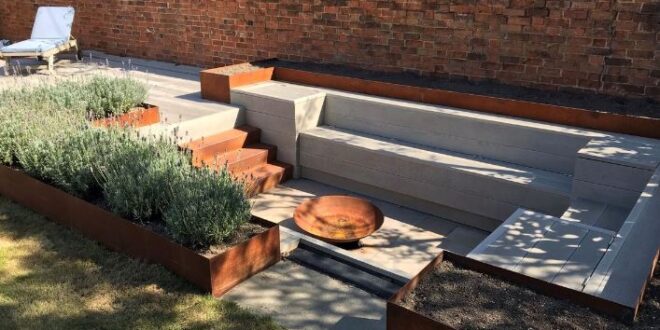Some gardens work best when wild and free flowing, while others work best when there’s order and separation between sections. If you prefer the latter type of garden, you’ll probably already use garden edging.
Garden edging can be used to edge lawns, border paths, to outline patios or seating areas or define different spaces within your garden.
It’s a subtle, but very useful method of adding an extra architectural feature but also defining all those different spaces within the space.
Like most things in the garden, how you express yourself within its design is entirely up to you. You can keep things modest and subtle or go large with more of a statement.
There are so many garden edging options around, it’s entirely up to you!
Practical garden edging ideas
There are many ways to section areas within the average garden and we have put together 10 ideas you can try.
Brick wall
A low brick wall or even something taller is a logical separator. It’s more labour intensive than some garden edging but it can also be more permanent.
You could use a brick wall to raise beds, to integrate seating or be purely decorative. Be imaginative with brick selection or use blocks instead. There are as many brick colours and options as there are gardens so you’re spoilt for choice.
Sleepers
Railway sleepers or new versions of the same are incredibly popular in garden edging. They are plentiful and cover a large area, which makes them relatively easy to use.
Old sleepers can weep tar so will need a little looking after. New sleepers need to be weathered or they’ll split, but are otherwise ready to go. They can be a little unwieldy, but you can cover a lot of ground with just a couple of sleepers.
Metal edging
Metal edging is another very practical garden or lawn edging idea. There are many types of metal but the most popular right now is Corten steel. It’s the steel that looks rusty even though it isn’t.
Metal edge provides clean distinction between areas and can be subtle and ground level or more architectural with taller or shaped installations. There’s something powerful about using metal in a garden as it’s the opposite of the natural look of the surroundings.
Paving
Using paving as lawn or garden edging is similar to zoning interiors using different colour floors. It’s a subtle but clear message that says they are completely different areas.
The signal may be subtle but the effect can be very compelling. It’s a useful way to end one paved space and begin a lawned or grown space and requires only modest effort to pull off.
Plastic edging
We’re not huge fans of plastic edging but there’s no knocking its ease of use or the amount of ground you can cover in relatively little time. Buy a decent quality plastic edging system and it can look okay too.
Plastic edging is ideal for edging vegetable plots or lawns and can be a very subtle way to separate spaces.
Garden furniture
We have seen a few ways garden furniture can edge a space. Corner seating with a solid base is one way and a garden bench with a solid base is another. The key seems to be that solid base that creates a clear distinction between two areas.
Garden furniture is another subtle market between areas that provides a clear division of spaces while offering the practicality we want.
Stone borders
Stone can make a lovely statement and can cover a lot of ground depending on the configuration of that stone. You also have multiple colour and texture options with stone, which is why it’s so popular.
Stone takes a little more installation than other border types, but once laid, could potentially last decades with very little maintenance.
Rocks or boulders
Rocks or boulders can also provide a clear divide between garden spaces. There are lots of shapes, sizes and colours available and the randomness of those can add character to almost any garden space.
While handling rocks can be a challenge, they require minimal installation so can be laid and in place in no time. Once there, they provide a definite divide between zones.
Hedging
Hedging can also be good garden edging. You can go low level or modest in smaller spaces or go large in more extensive gardens. Either way, hedging can provide colour, texture and shape.
Hedging requires patience as it will need to establish itself and grow, but once done, can provide a living edge that can be shaped however you like.
Wicker or woven materials
Wicker or woven reeds or vines can also be used as effective garden edging. It’s a more natural approach that can provide a subtle divide between areas of your garden.
Choosing the right wicker edging or other woven dividers is key here. Some cheaper options really don’t look natural or that good, while other options can work amazingly well.
Whatever garden edging option you choose, it can provide a clear divide between different areas of your garden.
Some gardens will work better with subtlety while others will work best with contrast or the starkness provided by some materials.
 Gardeners Club The Gardeners Club is a free to join online club for everyone with an interest in gardening and gardens.
Gardeners Club The Gardeners Club is a free to join online club for everyone with an interest in gardening and gardens.






